|
1.
CENTRAL AND WEST AFRICA
Rain season and stockpiling
After an extended dry spell rains have returned across
Cameroon and northern Congo. Gabon remains
unexpectedly wet despite the onset of the dry season.
Upstream operators in all three countries had anticipated
the weather shift and accumulated adequate logs and built
up sawnwood inventories. These moves cushion the
industry against transport slowdowns and allow
production to continue despite the weather conditions.
Across the region producers indicate markets remain
subdued and have observed buyers are drawing down
existing stocks rather than placing new orders.
Many Chinese-owned sawmills have either shut down
entirely or cut back production to one-shift schedules. A
few are now considering milling species outside of which
the Chinese importers prefer but with little fresh contract
activity inventories continue to mount.
Cameroon
Forestry and finance authorities maintain strict controls
over harvesting permits, production volumes and export
documentation. With rains now recurring transport on
laterite roads is beginning to slow though ample pre‐rain
stocks have so far prevented major supply disruptions.
During periods of intense rain transportation sometimes
stops entirely. Trucking firms are on alert for any road
washouts and maintain contingency routes.
It is rumoured that several foreign owned sawmills have
closed only to reopen with new corporate identities. Aside
from this manoeuvring, spare‐parts imports remain
adequate and no major labour disputes have been reported.
The Port of Douala has seen shipment volumes dip
reflecting lower log volumes arriving from northern
Congo and the Central African Republic. Empty
containers are readily available in both Douala and Kribi
and stuffing operations are functioning normally. The
balance of container traffic favours exports of sawnwood
through Kribi.
Gabon - regulatory shifts and utilities strained
It is reported that aerial surveillance of logging
concessions has intensified and operators face an
additional “community payment” of 800 CFA per cubic
metre on top of existing taxes. These levies, coupled with
tepid global demand, are squeezing profit margins.
Electricity outages persist. The undersea cable repair is
expected to take several more weeks and many wood
processors have reverted to using generators.
The growing interest in overseas markets in Brazilian pine
over Okoume is reportedly already depressing Okoume
prices as mills and veneer producers turn to the cheaper,
readily available pine.
Congo - Indigenous voices and quiet markets
Timber sector activity remains muted. Recently
Brazzaville hosted a high‐level forum on supporting
indigenous forest communities focused on securing social
services, land rights and fair revenue sharing.
Logging, milling, and exports are proceeding with
minimal disruption supported by existing inventories and
the onset of the local dry season in the south.Harvesting
activity has slowed as demand remains quiet. Many are
saying demand in China has collapse such that mills are
compelled to diversify into European species even though
log inventories of Sapelli, Sipo and other redwoods exceed
two to three months’ processing capacity.

2.
GHANA
Independent Natural Resource Commission
proposed
A legal practitioner and senior partner of Bentsi-Enchill,
Letsa & Ankomah, Ace Anan Ankomah, has called for the
establishment of an Independent Natural Resources
Commission to serve as a one-stop regulator for the
natural resource sector.
According to Mr. Ankomah, a single consolidated body
should replace the fragmented commissions in the natural
resource sector to address gaps in regulation. He further
explained that an Independent National Prosecutions
Authority could eliminate executive influence over
prosecutions, uphold the rule of law.
Mr. Ankomah made these suggestions when he presented
a paper on “Overhaul of national institutions regulating
mining: role of local institutions including chiefs.” at the
Ghana Academy of Arts and Sciences (GAAS) Public
Forum 2025 on the theme: “Galamsey Revisited: A
National Dialogue on Solutions”.
The lawyer explained that the proposed Independent
Natural Resources Commission, which must be
constitutionally insulated from executive control, would
help to eliminate confusion and regulatory overlap and
improve coordination and sustainability.
The Commission would accept only broad policy direction
from the government not operational interference. That
would take away licensing powers from ministers, leaving
them with general policy-making roles only.
In a related development, the Asantehene, Otumfuo Osei
Tutu II, has called on the mining sector to adopt a new
approach that prioritises sustainable development and
equitable distribution of resources. Otumfuo emphasised
the need for the industry to move in a direction that
maximises benefits while minimising negative impacts.
See: https://www.graphic.com.gh/news/general-news/ghana-
news-ace-ankomah-advocates-establishment-of-independent-
natural-resources-commission.html
and
https://www.myjoyonline.com/asantehene-urges-mining-sector-
to-chart-new-path-towards-sustainable-development/
and
https://presidency.gov.gh/govt-implementing-new-measures-to-
combat-illegal-mining-including-excavator-import-permits/
Five wood products account for most first quarter
exports
According to the Timber Industry Development (TIDD)
report seventeen different wood products were exported
during the first three-months of 2025. These together
contributed to the total volume of 57,844cu.m valued at
Eur27.50 million, registering decreases in volume and
value of 10% and 6% respectively compared to the same
period in 2024.
Of these, the five leading products were air-dried
sawnwood (58%), kiln-dried sawnwood (13%), billet
(12%), plywood to the regional market (6%) and rotary
veneer (3%) contributing to 93% (53,774cu.m) of the total
export volume for the period in 2025. For the same period
in the previous year, these products contributed
55,225cu.m representing 86% of the total export volume.
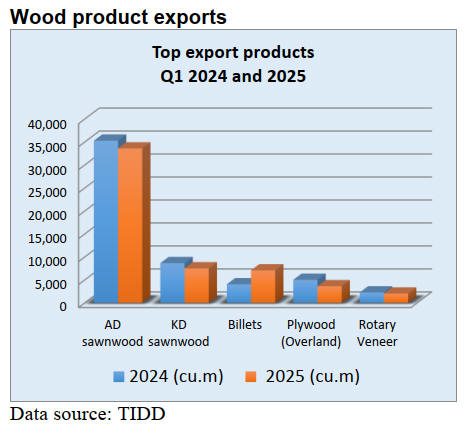
Billet export volumes during the first quarter of 2025
improved by 75% to 7,062 cu.m (Eur2.18million), from
4,038 cu.m (Eur1.21million) in 2024. While the remaining
four wood products recorded declines in export volumes.
In the first quarter 2025 wood products were exported to
Ghana’s major markets namely Asia, Europe, Africa,
America and Middle East countries accounting for 69%,
14%, 9%, 5% and 3% respectively of the total volume for
2025.
The total receipts of wood products for these major market
destinations dipped to Eur27.50 million in 2025 from the
figure of Eur29.33 million in 2024. Table 2 below shows
the revenue generated by these markets for 2024 and 2025:
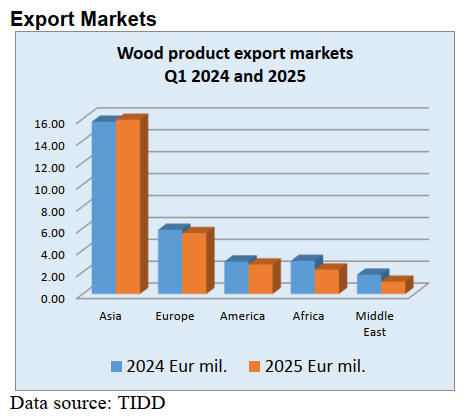
Asian markets accounted for 58% (Eur15.91 million) of
the total revenue in 2025 compared to 54% (Eur15.73
million) in 2024 for the same period. The Europe market
accounted for 20% in 2025 and 20% in 2024.
However, receipts from wood product exports to America,
Africa and Middle East countries in the first quarter 2025
fell compared to the same period in 2024.
The regional African markets, at Eur2.22 million, were in
4th position in terms of revenue earned in the first quarter
2025. Wood products exported to African markets
included plywood, KD and AD sawnwood, rotary veneer,
sliced veneer and poles.
Traders’ association call for duty cuts following
appreciation of the Cedi
The Executive Secretary of the Importers and Exporters
Association, Samson Asaki Awingobit, has called on the
government to accelerate efforts to reduce port duties,
warning that the current charges are pushing up the cost of
goods across the country despite the cedi appreciation.
Mr. Awingobit said the government must speed up the
process of engaging importers, exporters, Traders’
Associations, among others, to help reduce product prices
in the market. He further explained that high port charges
add to the overall cost burden on goods which affects
retail prices and consumer spending.
According to Awingobit, government’s intervention to
reduce the high port tariffs would help stabilise prices and
improve affordability. Players in the timber manufacturing
industry import machinery and spares which attract
charges at the port for their operations.
Speaking at a meeting with the Federation of Association
of Ghanaian Exporters (FAGE) the President
acknowledged the recent currency appreciation but
cautioned against an excessively strong cedi which could
harm export competitiveness.
Following the appreciation of the local currency which is
around 30% since the beginning of the year there have
been mixed responses from the various sectors of traders
to adjust their prices.
See: https://www.graphic.com.gh/business/business-
news/importers-exporters-call-for-urgent-tarrif-cuts.html
and
https://www.graphic.com.gh/news/general-news/ghana-news-
cedi-to-stabilise-around-ghc10-ghc12-band-against-dollar-
president-assures-exporters.html

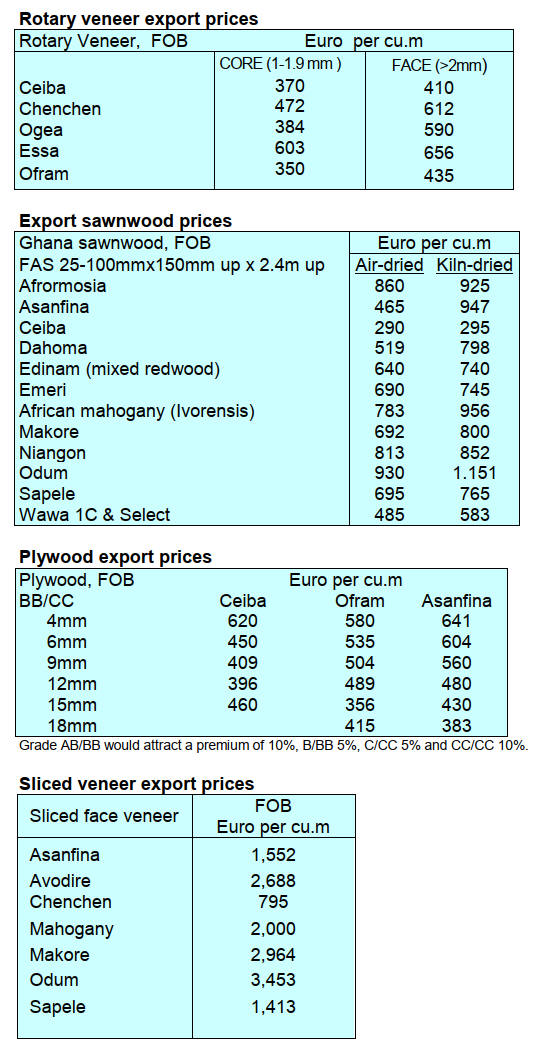
3. MALAYSIA
Review of the timber certification scheme standards
The Malaysian Timber Certification Council (MTCC) is
conducting a scheduled review of the two standards under
the Malaysian Timber Certification Scheme (MTCS). This
review aims to ensure continued relevance, alignment with
international requirements and incorporation of national
and stakeholder interests.
The review of the Malaysian Timber Certification Scheme
(MTCS) standards, particularly MTCS ST 1002:2021
Malaysian Criteria and Indicators for Sustainable Forest
Management and MTCS ST 1003:202 Group Forest
Management Certification Requirements, is a crucial
process to ensure their continued relevance, credibility and
alignment with international best practices in sustainable
forest management and certification.
This review is mandated by MTCS ST 1001:2021
Standard Setting Procedures for Forest Management
Certification Standards, which requires a periodic revision
of all standards under the scheme at least every five years
or sooner if necessary. It also reflects the need to address
evolving environmental, social and economic challenges,
as well as stakeholder expectations at both national and
international levels.
Furthermore, alignment with the Programme for the
Endorsement of Forest Certification (PEFC) requirements,
particularly PEFC ST 1001:2017 Standard Setting
Requirements and PEFC GD 1007 Endorsement and
Mutual Recognition of Certification Systems and their
Revision, is essential to maintain MTCS’s endorsement
status and ensure compatibility with the latest PEFC
benchmark standards.
The MTC website says, “through this review the MTCC
aims to enhance the effectiveness, clarity, and
implementability of its standards while strengthening
stakeholder confidence and international recognition. In
line with that, MTCC is soliciting feedback on the existing
standards, particularly MTCS ST 1002:2021 and MTCS
ST 1003:2021”.
See: https://mtcc.com.my/mtcs-standard-review-initial-
feedback-on-existing-standards/
Timber Legality System strengthening workshop
Ensuring effective compliance with regulations is
paramount in establishing a sustainable timber business
and fostering credibility with government agencies.
Therefore, government agencies such as Malaysian
Timber Industry Board (MTIB) are entrusted with the
responsibility of developing and implementing stringent
regulations that optimise outcomes by maximising
compliance levels.
In light of this the Licensing and Inspectorate Division is
engaged in the drafting of the Malaysian Timber Industry
Board Regulations (Issuance of Timber Export and Import
Permits), designed to enforce MTIB's role as a regulatory
authority in the timber sector.
To ensure that the new regulations are pertinent to the
current permit issuance procedure MTIB recently held the
first of the MTIB Timber Legality System Strengthening
Workshop Series.
See: https://www.mtib.gov.my/en/maskayu/category/46-
emaskayu-2025.html
Diversify markets or relocate production – options
being discussed
The New Straits Times has reportedthat as US import
tariffs rise Malaysian furniture makers may look beyond
the United States market and may even consider shifting
operations to countries with more favourable trade terms.
The newspaper continues “while the US remains
Malaysia's largest furniture export destination, accounting
for RM7.03 billion in sales last year, the sharp cost hike
may prompt buyers to shift to alternative sourcing
countries”.
The Federation of Malaysian Manufacturers (FMM) noted
that the additional tariff burden could erode Malaysia's
pricing edge and reshape buyer sentiment.
FMM president, Tan Sri Soh Thian Lai, said " (US)
customers sourcing from Malaysia may begin redirecting
orders to countries not affected by similar duties,
particularly those with preferential access to the US or
with lower operating costs".
See:
https://www.nst.com.my/business/economy/2025/04/1207089/fur
niture-makers-may-carve-out-new-markets
4.
INDONESIA
Export Benchmark Price (HPE) April 2025
The following is a list of Wood HPE from 1 June to 30
June 2025.
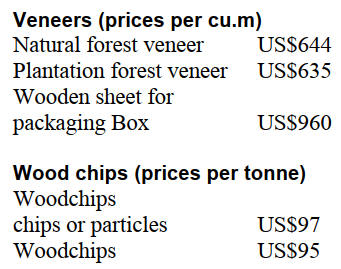
Processed wood (prices per cu.m)
Processed wood products which are leveled on all four
sides so that the surface becomes even and smooth with
the provisions of a cross-sectional area of 1,000 sq.mm to
4,000 sq.mm (ex 4407.11.00 to ex 4407.99.90)
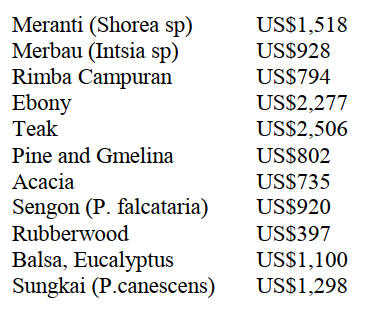
Processed wood products which are leveled on all four
sides so that the surface becomes even and smooth of
Merbau wood with the provisions of a cross-sectional area
of 4000 sq. mm to 10,000 sq.mm (ex 4407.11.00 to ex
4407.99.90) = US$1,500/cu.m.
See: https://jdih.kemendag.go.id/peraturan/keputusan-menteri-
perdagangan-republik-indonesia-nomor-1483-tahun-2025-
tentang-harga-patokan-ekspor-dan-harga-referensi-atas-produk-
pertanian-dan-kehutanan-yang-dikenakan-bea-keluar
SVLK relaxation could weaken Indonesia's reputation,
say experts
A proposed relaxation of the Timber Legality Verification
System (SVLK) has sparked concerns among
environmental groups and forestry experts who fear it
could damage the country's reputation in international
markets.
Senior Campaigner Deny Bahtera of Kaeom Telapak
warns that easing SVLK requirements, especially for
exports outside Europe and the UK, could allow illegal
timber to mix with legal products undermining years of
efforts to ensure sustainable forest management.
Forestry expert, Diah Suradireja, emphasised that the
SVLK is crucial for Indonesia to comply with the EU's
Deforestation-free Products Regulation (EUDR) and
maintain market trust. Relaxing the system could lead to
a loss of market share for Indonesian wood products. Both
experts advocate for strengthening SVLK rather than
weakening it, urging the government to resolve the
controversy to protect Indonesia's credibility in forestry.
See:
https://lestari.kompas.com/read/2025/05/28/200700086/relaksasi-
svlk-dinilai-lemahkan-reputasi-kayu-indonesia.
and
https://www.msn.com/id-id/berita/teknologidansains/pelemahan-
svlk-kehutanan-berlanjut-daya-saing-produk-kayu-indonesia-
dipertaruhkan/ar-AA1FGvlF?ocid=BingNewsVerp
and
https://www.tempo.co/lingkungan/aktivis-desak-pemerintah-
batalkan-pelemahan-aturan-verifikasi-kayu-ri--1543669
In related news, the Independent Forestry Monitoring
Network (JPIK) asserts that strengthening Indonesia's
Timber Legality and Sustainability Assurance programme
(SVLK) is a sound economic strategy. According to JPIK,
SVLK has driven significant export growth, improved
access to premium markets and fostered long-term market
confidence. They emphasise that maintaining SVLK's
integrity is vital for expanding Indonesia's global market
share.
JPIK advocates for collaboration with the Ministry of
Forestry and other stakeholders to develop trade policies
that address tariff challenges without compromising
Indonesia's long-term economic interests.
See: https://www.antaranews.com/berita/4862277/jpik-nilai-
penguatan-svlk-strategi-ekonomi-yang-baik-bagi-indonesia
and
https://hijau.bisnis.com/read/20250528/651/1880590/svlk-
produk-kayu-dukung-perdagangan-legal-dan-berkelanjutan.
Indonesia-EU CEPA Nears Completion as Final
Hurdles Cleared
The Indonesian government is close to finalising
the Indonesia-European Union Comprehensive Economic
Partnership Agreement (IEU-CEPA) having reached
consensus on all outstanding issues.
Coordinating Economy Minister, Airlangga Hartarto,
confirmed that the final technical matters have been
resolved after nine years and 19 negotiation rounds. This
agreement reflects Indonesia's commitment to expanding
market access, boosting investment and reducing trade
barriers with strategic partners.
The EU is Indonesia's fifth-largest trading partner, with
bilateral trade reaching US$30.1 billion in 2024. The IEU-
CEPA is projected to significantly lower import duties
with up to 80% of Indonesian exports to the EU benefiting
from zero tariffs within two years of implementation.
Key sectors poised to benefit include labour-intensive
industries like footwear, textiles and garments as well as
palm oil, fisheries, renewable energy and electric vehicles.
Indonesia has also secured equal treatment for its fishery
exports and special consideration from the EU regarding
its deforestation policy. Minister Hartarto affirmed the
mutually beneficial nature of the pact, its long-term
sustainability and its strategic importance in enhancing
Indonesia's global competitiveness and attracting
European investment, noting that "No obstacles remain."
See: https://www.thejakartapost.com/adv/2025/06/08/ieu-cepa-
nears-completion-as-indonesia-eu-resolve-final-hurdles.html.
and
https://jakartaglobe.id/special-updates/indonesiaeu-cepa-
negotiations-enter-final-stage
Indonesia and IKEA to boost MSME business
opportunities
The Indonesian Ministry of Trade has signed a MoU
with IKEA Indonesia to expand the market reach and
strengthen business management of Indonesian micro,
small and medium enterprises (MSMEs). This partnership
will allow MSMEs to showcase their products in IKEA
stores thereby broadening their market access.
Action will include programmes to enhance product
quality and competitiveness for the local market as well as
the "UMKM BISA Ekspor" initiative to facilitate overseas
expansion through business matching events in 33
countries.
The collaboration aims to not only market local products
through IKEA Indonesia's stores but also integrate them as
local partners in IKEA's global supply chains.
See: https://en.antaranews.com/news/357849/indonesia-ties-up-
with-ikea-to-boost-msme-ecosystem-market-reach
Indonesia and France cooperation on sustainable
forest efforts
Indonesia and France have solidified their commitment
to sustainable forest management by signing a declaration
of intent. Signed by Indonesian Minister of Forestry, Raja
Juli Antoni and French Minister of State, Thani Mohamed
Solihi, highlights both nations' dedication to strengthening
cooperation in forestry, environmental management and
climate change initiatives.
The signing was witnessed by Presidents Prabowo
Subianto and Emmanuel Macron who determined this is a
concrete step towards forest conservation, ecosystem
restoration and sustainable resource management with a
shared goal of halting deforestation and forest degradation
by 2030. The declaration outlines future collaboration on
rehabilitation, biodiversity conservation, national and
"sister" park development, social forestry and legal timber
trade.
This renewed partnership will involve information
exchange, joint projects, business and institutional
involvement, and continuous dialogue, aiming to revive
previous forestry collaborations.
See: https://en.antaranews.com/news/356993/indonesia-france-
bolster-sustainable-forest-efforts
Significant decline in Indonesian forest and land fires
Indonesian Forestry Minister, Raja Juli Antoni, announced
a substantial reduction in forest and land fires across the
country over the last ten years. Speaking in Pontianak,
West Kalimantan, he presented data showing the affected
area decreased from 2.6 million hectares in 2015 to 1.6
million hectares in 2019 and further dropped to 1.1 million
hectares in 2023.
The Minister attributed this success to strong collaboration
among various stakeholders including central and regional
governments, the Indonesian Military (TNI), National
Police (Polri) and local communities. Despite this progress
he urged continued vigilance and strengthened
preparedness.
He emphasised three core pillars for fire control: cross-
sectoral collaboration, effective law enforcement and
active public participation. The Minister specifically
praised the dedication of the Manggala Agni forest and
land fire handling organisation and the Fire-Alert
Community (MPA), recognising them as crucial
frontliners.
The government has designated 518 villages nationwide,
including 52 in West Kalimantan, as target areas for
enhanced forest and land fire control.
See: https://en.antaranews.com/news/358065/significant-drop-in-
forest-land-fires-in-past-decade-minister
Indonesian furniture showcased in Lebanon
Indonseia participated in the "Art of Living 2025"
exhibition in Lebanon 28 May to 1 June to promote
Indonesian furniture.
Showcased were wooden, rattan and bamboo furniture.
The exhibition was opened by Lebanon's Minister of
Economy and Trade, Amer Bisat, who praised Indonesia
for its high-quality and competitively priced products. In
2024, Indonesia's total exports to Lebanon reached
US$108.4 million, with furniture and home decor
accounting for US$88.494 million.
See: https://en.tempo.co/amp/2012870/embassy-in-beirut-
showcases-indonesian-furniture-to-lebanese-market
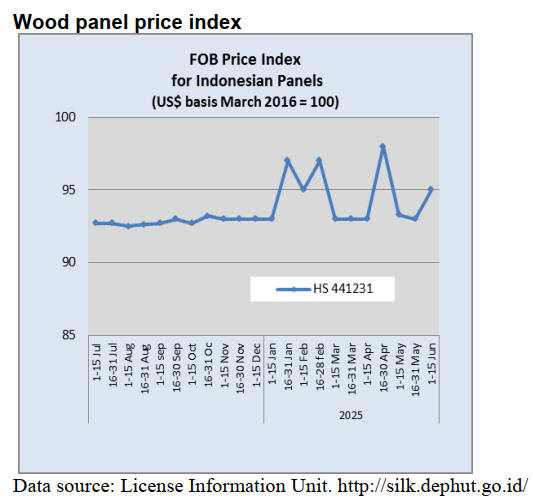
5.
MYANMAR
Earthquake-hit Myanmar invites foreign investor for
rebuilding
Myanmar is inviting foreign investors to participate in
redevelopment efforts two months after the devastating
earthquake destroyed major infrastructure and left
thousands homeless. Roads, bridges, schools, monasteries,
farmland and factories were destroyed when the 7.7
magnitude earthquake struck the South-East Asian nation
on 28 March.
State Administration Council Chairman Senior General
Min Aung Hlaing announced strategic plans to channel
further humanitarian aid to affected victims and quickly
reboot the country’s faltering economy.
The government has outlined three development
strategies: extend humanitarian relief and social
protection, infrastructure reconstruction and reviving the
economy.
See:
https://www.nationthailand.com/blogs/news/asean/40050691
Role of the border trade
Due to increasingly stringent import regulations the role of
border trade, both formal and informal, has become more
prominent. Under the current foreign exchange policy
35% of export earnings must be converted at the official
fixed rate of 2,100 MMK per US dollar.
The remaining 65% must be converted through the Central
Bank of Myanmar (CBM) controlled online trading
platform, where rates have fluctuated between 3,500 and
4,000 MMK per US dollar.
The market exchange rate has hovered around 4,400
MMK over the past four months. As a result, the effective
average exchange rate available to exporters is
approximately 3,200–3,300 MMK per US dollar.
While the government’s import control measures,
combined with informal exchanges, have helped maintain
some stability in the informal exchange market there have
been unintended consequences. Notably, commodity
prices have not decreased in line with the stronger
informal exchange rate. This disparity has prompted many
importers of essential goods to rely more heavily on
border trade routes.
However, the border trade environment remains complex
and costly. Weak law enforcement, security issues
involving ethnic armed group and rising concerns over
online scams have added considerable risks and expenses
for traders. Myanmar shares extensive land borders with
several countries: approximately 2,400 km with Thailand,
2,200 km with China, 1,600 km with India and 270 km
with Bangladesh.
A wide variety of goods flow through these borders,
including considerable volumes of timber.
See: https://www.ide.go.jp/English/Publish/Reports/Dp/625.html
https://www.burmalibrary.org/en/the-role-of-informal-cross-
border-trade-in-myanmar
UN Warns Myanmar on “Path to Self-Destruction”
Myanmar is on "a path to self-destruction" unless the
ongoing violence gripping the country comes to an end
warned UN Special Envoy, Julie Bishop, in an address to
the UN General Assembly.
She emphasised that even a devastating earthquake in late
March which killed over 3,000 people and injured
thousands more in Naypyitaw and Mandalay failed to halt
the fighting. “A zero-sum approach persists on all sides,”
Bishop stated. “Armed clashes remain a barrier to meeting
humanitarian needs. The flow of weapons into the country
is fueling the expectation that a military solution is
possible.”
Widespread job losses, soaring prices and inadequate
public services have pushed many into desperate coping
strategies such as cutting food intake, consuming less
nutritious meals, selling household assets, forgoing
healthcare and even withdrawing children from school to
supplement family income. In response, the UNDP, UN
Women and UN-Habitat have launched an Urban
Resilience Project to support the most vulnerable
communities.
See: https://news.un.org/en/story/2025/06/1164231
6.
INDIA
Inflation falls
The annual rate of inflation based on the all India
Wholesale Price Index (WPI) was 0.85% in April down
from 2.05% in March. The positive rate of inflation in
April was primarily due to increased prices for
manufacture of food products, other manufacturing,
chemicals and chemical products, manufacture of other
transport equipment and manufacture of machinery and
equipment.
The index for manufacturing rose to 144.9 in April 2025
from 144.4 in March. Out of the 22 NIC two-digit groups
for manufactured products, 16 groups witnessed an
increase in price, 5 groups witnessed a decrease in price
and 1 group witnessed no change in price.
Some of the important groups that showed month on
month increases in price were manufacture of basic
metals, chemicals and chemical products, fabricated metal
products (except machinery and equipment), machinery
and equipment and other manufacturing.
Some of the groups that witnessed a decrease in prices
were manufacture of textiles, pharmaceuticals, medicinal
chemical and botanical products, paper and paper
products, apparel and printing. The indices for sawnwood
and veneer increased.
See: https://eaindustry.nic.in/pdf_files/cmonthly.pdf
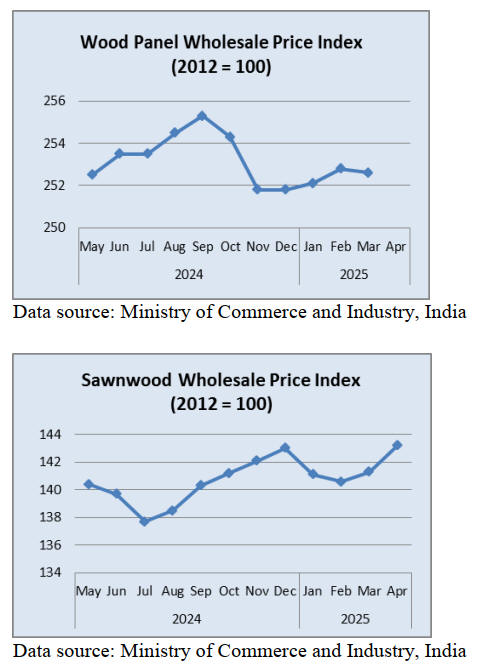
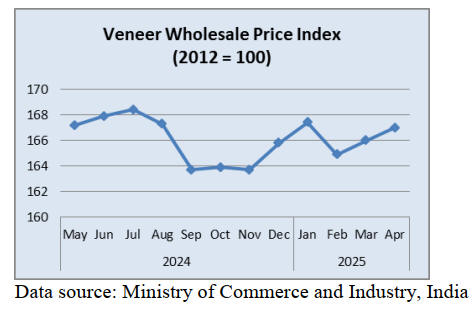
Imports of core veneer
Prices for domestically milled veneers have been rising
but plywood mills in Gujarat, Rajasthan, West Bengal,
Maharashtra, Andhra Pradesh are using imported core
veneers from Viet Nam, Tanzania, Laos, Uganda, Brazil
and Nepal. Ply Reporter, in its May magazine, says
imported core veneers have reached plywood factories in
Northern Indian States such as Punjab, Haryana, Uttar
Pradesh, Union Territories and Bihar.
The increasing supply of imported core veneers comes as a
relief for industries now. Even plywood manufacturers in
the States of Kerala and Mangalore are exploring veneer
imports due tothe high price of local veneers.
See: https://www.plyreporter.com/plywood/news-updates#
Vessel with large volume of teak sinks
The Ministry of Defence has confirmed the sinking of a
Liberian registered container ship‘MSC ELSA 3 off the
Kochi coast. The ship is reported to have carried a large
amount of teak, core veneers, logs and face veneers along
with a considerable amount of hazardous chemicals.
See: ttps://www.plyreporter.com/article/154064/liberian-ship-
carrying-tonnes-of-timber-capsized-near-kochi-coast
‘Ek Ped Maa Ke Naam 2’ A tree plantation drive
Prime Minister Narendra Modi marked the 4 June World
Environment Day by planting a sapling in the national
capita, as part of the second phase of the ‘Ek Ped Maa Ke
Naam’ initiative. The campaign, which encourages
individuals to plant a tree in honour of their mothers, aims
to promote environmental consciousness through personal
and symbolic action.
The plantation drive also marks the anniversary of the
campaign’s launch. The theme of the campaign, planting a
tree in the name of one’s mother, seeks to blend
environmental action with cultural values.
See: https://ddnews.gov.in/en/pm-modi-to-launch-ek-ped-maa-
ke-naam-2-0-with-tree-plantation-on-world-environment-day/
Tropical forest loss - fire a leading cause
Fires caused by dry conditions resulted in record forest
loss in 2024. Globally the loss of tropical primary forests
reached 6.7 million hectares in 2024, nearly twice as much
as in 2023.
Global Forest Watch said in a statement last month that
India saw an almost 7% decrease in tree cover loss
between 2023 and 2024 but a 6% increase in loss of humid
primary forests in 2024.
One of the factors that may have led to increased primary
forest loss last year in India was forest fires the data
indicates. Primary forest loss due to fires was around 950
hectares last year compared to 368 hectares in 2023, a
158% rise. India lost 22,958 hectares of primary forest last
year and 21,672 hectares in 2023, 22,008 hectares were
lost due to non-forest drivers.
See: https://gfr.wri.org/latest-analysis-deforestation-trends
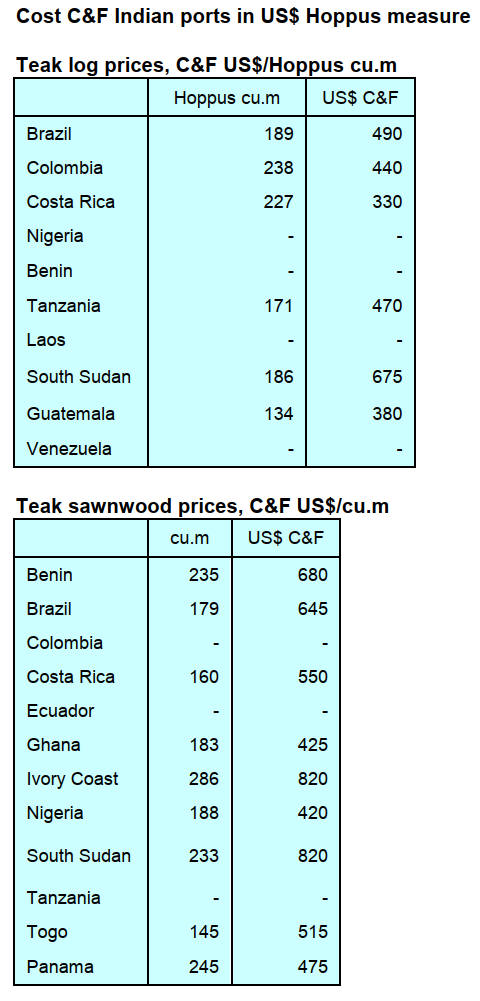 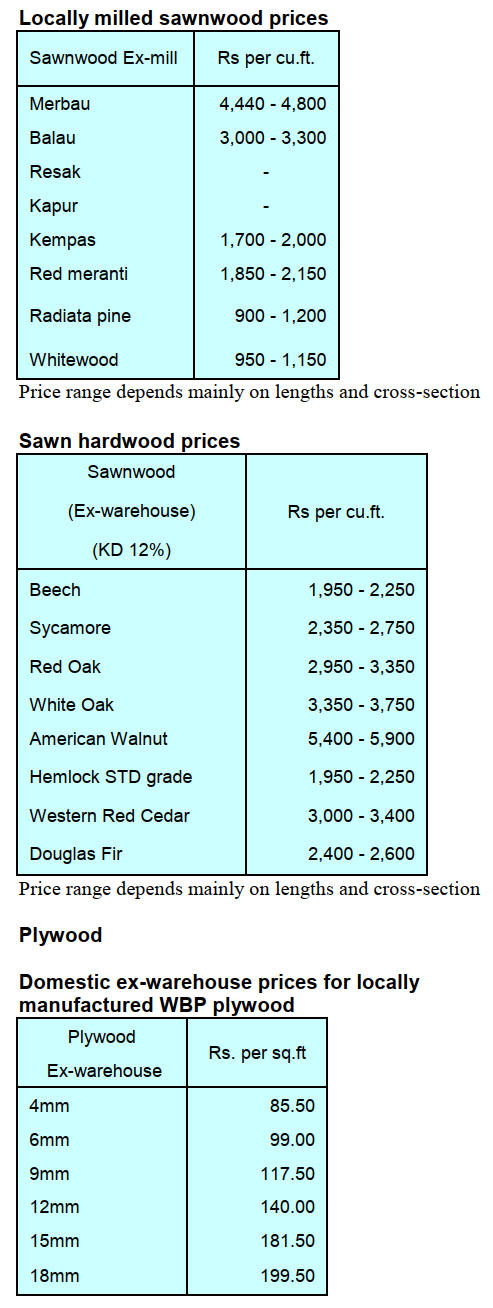 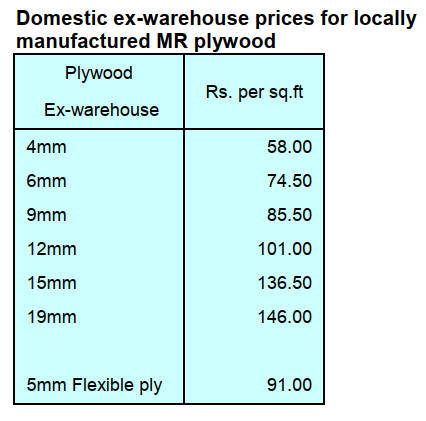
7.
VIETNAM
Wood and Wood Product (W&WP) trade
highlights
According to Viet Nam Customs statistics W&WP
exports to the Canadian market in May 2025 reached
US$24 million, up 41% compared to May 2024. In the
first 5 months of 2025 W&WP exports to Canada
reached US$117 million, up 24% over the same period
in 2024.
Viet Nam's office furniture exports in May 2025 stood
at US$33 million, up 41% compared to May 2024. In
the first 5 months of 2025 exports of office furniture
earned US$153.3 million, up 33% over the same period
in 2024.
Oak wood imports to Viet Nam in May 2025 were
33,800 cu.m, worth US$20.6 million, up 5% in volume
and 5% in value compared to April 2025 and an
increase of 6% in volume and 12% in value compared
to May 2024. In the first 5 months of 2025 imports of
this species amounted to 165,800 cu.m worth
US$100.3 million, up 23% in volume and 29% in value
over the same period in 2024.
Viet Nam's W&WP exports to South Korea in May
2025 earned US$78.2 million, up 26% compared to
May 2024. In the first 5 months of 2025 the W&WP
exports to the Korean market brought in about US$335
million, up 7% over the same period in 2024.
The exports of living and dining room furniture from
Viet Nam in May 2025 generated US$250 million, up
23% compared to May 2024. In the first 5 months of
2025 exports of living and dining room furniture
accumulated at US$1.1 billion, up 7.5% over the same
period in 2024.
Viet Nam's ash imports in May 2025 reached 65,900
cu.m, worth US$17.1 million, up 21% in volume and
22% in value compared to April 2025. Compared to
May 2024, imports increased by 24% in volume and
16% in value.
In the first 5 months of 2025 imports of ash wood
totalled 257,000 cu.m, worth US$65.2 million, up 42%
in volume and 36% in value over the same period in
2024.
Viet Nam’s imports of raw wood from Africa in April
2025 amounted to 49,450 cu,m with a value of
US$17.90 million, down 26% in volume and 24% in
value compared to March 2025. Imports were down
30% in volume and 29% in value over the same period
in 2024. In the first 4 months of 2025 imports of raw
wood from Africa reached 249,660 cu.m with a value
of US$88.41 million, up 24% in volume and 16% in
value over the same period in 2024.
Viet Nam - US trade ties make progress
A major step has just been made in Viet Nam - US trade
relations as Vietnamese businesses signed 20 memoranda
of understanding (MoUs) to import agricultural products
from the US, with a total estimated value of up to US$3
billion. The agreements were signed as part of a working
visit by a delegation from Viet Nam’s Ministry of
Agriculture and Environment to the states of Iowa, Ohio,
Maryland and Washington D.C.
The delegation, led by Minister Do Duc Duy, included
representatives from nearly 50 Vietnamese agencies,
agricultural businesses and associations. The visit aimed to
boost two-way trade and open up new opportunities for
Viet Nam to increase imports of US agricultural and wood
products. In addition, the delegation sought access to new
technologies to enhance the competitiveness of Viet
Nam’s agricultural value chain.
Businesses are hopeful that a trade agreement between the
two countries will soon be reached, helping lower tariffs
on agricultural products and consolidate shared supply
chains while contributing to the prosperity of both
countries under the framework of the Comprehensive
Strategic Partnership.
At a roundtable between the delegation and the US-
ASEAN Business Council (USABC) on 6 June, USABC
President and CEO, Ted Osius, expressed strong support
for Viet Nam’s agricultural development.
Rapid changes in US tariff policies have created a
challenging trade environment, he said, expressing his
appreciation that Viet Nam is considering increasing
imports of US agricultural products as a way to help
narrow the trade deficit with the US.
He pledged that the USABC and its member companies
will continue to support the growth of Viet Nam’s food
and agriculture sector. In response, Duy affirmed the
VietnameseGovernment’s strong commitment to
continuing institutional reforms, improving administrative
efficiency, upgrading infrastructure and creating the most
favorable conditions for foreign businesses, including US
companies, to expand their investment and operation in
Viet Nam in a long-term and effective manner.
According to Minister Duy, through forums and meetings,
the delegation has clearly demonstrated to US government
officials, state authorities, the business community, and
the American public that Viet Nam places great
importance on its Comprehensive Strategic Partnership
with the US.
See: https://en.Viet Namplus.vn/Viet Namus-trade-ties-make-
new-progress-post320598.vnp
Seeking solutions to preserve market presence in the
US
Reciprocal tariffs will present a significant obstacle to Viet
Nam's wood exports to the United States, however,
domestic wood businesses are endeavoring to preserve
their market share in this critical market.
Viet Nam's wood and wood product exports to the United
States have maintained growth despite concerns regarding
potential reciprocal tariffs. April saw a 4% year on year
increase in exports to the United States. The total export
value to the United States during the first four months of
2025 was US$2.9 billion, a 10% increase from the same
period in 2024.
At present the United States market takes over half of Viet
Nam's total wood and wood product exports, a proportion
that is slightly higher than that of the previous year (54.4%
versus 54.1%). These figures suggest that Vietnamese
exporters are accelerating shipments to the United States
in response to the temporary suspension of tariff
enforcement by the U.S. government. The figures also
highlight Viet Nam's dependence on the American market.
Adapting to alternative markets following implementation
of tariffs will be challenging due to the U.S.'s dominance
in Viet Nam's wood export portfolio.
Products designed for the United States may not be
appreciated in other markets as each market has its own
unique standards and preferences for wooden products.
Furthermore, the vast size of the U.S. market makes it
difficult for other markets to fully compensate for any lost
demand.
Currently, wood companies are not only striving to
optimise the flow of their products to the United States but
they are also anticipating that the tariffs will eventually
remain within a manageable range. American importers
are currently grappling with the challenge of locating
substitute sources as Vietnamesewood products comprise
nearly half of all U.S. wood imports. This is particularly
challenging given that China, the second-largest supplier,
is already subject to high tariffs.
Viet Nam is also prioritising the procurement of wood raw
materials from the United States in order to achieve a trade
balance and demonstrate goodwill. Mr. Ngo Sy Hoai, Vice
Chairman of the Viet Nam Timber and Forest Product
Association, has stated that American timber is
experiencing export challenges to China as a result of the
ongoing tariff disputes between the United States and
China.
As a result, Viet Nam's increased imports of U.S. logs and
sawnwood not only indicates cooperation but also
contributes to the reduction of trade imbalances between
the two countries.
Vietnameseexporters are also able to reduce the effects of
reciprocal tariffs by utilising U.S. sourced timber for
furniture exports to the American market. Mr. Do Ngoc
Hung, Viet Nam's Commercial Counselor in the United
States, clarified that tariffs would only apply to the non-
U.S.-origin portion of Vietnamese products that contains
at least 20% U.S.-origin materials or inputs.
Statistics regarding imports corroborate this development.
In the initial three months of 2025, Viet Nam Customs
reported that the importation of U.S. timber amounted to
191,000 cubic metres, with a value of nearly US$79
million. This represents a 34% increase in volume and a
28% increase in value compared to the previous year.
Many Vietnamese timber companies are resolute in their
efforts to preserve their market position, despite the
imposition of tariffs as they recognise the significance of
the US market. Expanding business-to-consumer sales
directly to US consumers through e-commerce platforms
such as Wayfair and Amazon is one emerging solution.
Mr. Huynh Le Dai Thang, Director of Nghia Son Furniture
Production and Trading Co., Ltd. disclosed that his
business has been conducting business-to-consumer (B2C)
transactions for more than three years. Currently, B2C
accounts for approximately 10% of the organisation's total
export revenue.
Viet Nam's wood industry is actively diversifying export
markets in addition to sustaining its U.S. presence. China,
Japan, India, the United Kingdom, Canada, Australia and
the Middle East are among the most promising.
See: https://Viet Namagriculture.nongnghiep.vn/Viet Nams-
wood-industry-seeking-solutions-to-preserve-market-presence-
in-the-us-d755975.htmldestinations
IWPA welcomes Viet Nam delegation for dialogue on
legal and sustainable timber trade
The International Wood Products Association (IWPA)
recently met with a delegation from Viet Nam’s
government and timber industry for a high-level dialogue
on sustainable trade in wood products.
The meeting was held on 7 June at the Washington office
of Forest Trends. IWPA executives and the Viet Nam
wood products industry explored opportunities to deepen
cooperation and advance the shared goal of promoting
legal and sustainable timber trade. The discussions
included an exchange of policy updates, trade priorities
and areas for future cooperation.
IWPA was represented by Ashley Amidon, Chief
Executive Officer; Joe O’Donnell, Director of
Government & Public Affairs and Bryan Courtney,
President of IWPA and Director of Industrial Products at
Genesis Products.
Ms. Amidon delivered a presentation titled “U.S. Trade
Policy Updates: Emphasis on Wood Products from Viet
Nam,” offering insight into recent developments in U.S.
trade policy and underscoring the importance of
responsible sourcing and transparent supply chains.
The Vietnamese delegation included Dr. Tran Quang Bao,
Director General of the Viet Nam Administration of
Forestry (VNFOREST), along with top representatives
from the Viet Nam Timber and Forest Products
Association (VIFOREST), the Handicraft and Wood
Industry Association of Ho Chi Minh City (HAWA) and
the Dong Nai Timber and Forest Products Association
(DOWA).
Bao emphasised the Vietnamese government’s recent
efforts in promoting legal and sustainable trade, including
the implementation of a Voluntary Partnership Agreement
(VPA) with the EU, a timber agreement with the US and
preparations for the EUDR.
“This meeting reaffirmed the strong potential for
collaboration between US importers and timber sectors
around the world,” said Ms. Amidon. “Viet Nam continues
to focus on advancing regulations that promote legal and
sustainable timber production and trade. IWPA looks
forward to building on this foundation to foster mutually
beneficial trade relationships that support forest
stewardship, economic growth and international market
access.”
See: https://mkresourcesgovernance.org/en/2025/06/08/Viet
Nams-forestry-sector-strives-to-strengthen-cooperation-with-u-s-
partners/
8. BRAZIL
Challenges faced by wood-based industries
The Forest Based Industry Chamber of FIEMG
(Federation of Industries of the State of Minas Gerais) met
to discuss environmental and regulatory challenges faced
by the foresry sector in the State.
The event brought together business leaders, experts and
public sector representatives. During the opening session
the President of the Chamber and SINDIFER (Minas
Gerais State Union of the Iron, Steel and Other Basic
Metals Industry) emphasised the importance of dialogue
between the business sector and government authorities
for the development of public policies that support the
growth of the forest-based industry sector.
.
He stressed the need for alignment between public policies
and sector´s demands, warning that measures such as
reducing working hours could negatively affect the
competitiveness of industrial enterprises operating
continuously, particularly those operating on a 24-hour
shift schedule.
FIEMG’s Environment and Sustainability Management
(GMA FIEMG) also presented on the main advances in
discussions and the challenges of environmental policies at
the National Environmental Conference, emphasising the
importance of the event for future regulations impacting
the forest sector.
The presentation highlighted the “FIEMG’s 360 Program,”
which aims to ensure the industry’s representation in
public hearings, especially on environmental issues. The
programme currently has around 900 participants working
to defend the industrial sector’s projects seeking to
balance debate and strengthen the industry’s position.
Another important topic was the analysis of the draft
Normative Resolution of CERH-MG (State Water
Resources Council of Minas Gerais), which addresses the
suspension and revocation of water use rights due to non-
payment of water usage fees.
The debate raised concerns about the potential impacts of
this measure on the sustainability of forest industry and
discussed alternatives to ensure the responsible use of
water within the sector.
See: https://www.maisfloresta.com.br/camara-da-industria-de-
base-florestal-discute-desafios-ambientais-e-regulatorios/
Incentives for restoration of natural forest areas
A new environmental programme is being implemented in
the State of Santa Catarina in southern Brazil to restore
degraded Permanent Preservation/Protected Areas (APPs)
within the Uruguay River Basin.
The initiative covers 148 municipalities and is supported
by partnership among Epagri (Santa Catarina Agricultural
Research and Rural Extension Company), Foz do Chapecó
Energia, Sicoob (Brazilian Credit Union System) and local
rural producers. The programme focuses on the restoration
of degraded areas, the recovery of water resources and
wildlife and the environmental enhancement of rural
properties.
The programme targets landowners with anthropised
(APPs) areas that require ecological restoration.
Participating landowners will receive technical and
financial support of around R$13,000 per hectare restored
subject to meeting specific planting and conservation
targets.
The requirements include fencing off the restoration area
and the planting of 600 native tree seedlings per hectare,
such as Anadenanthera macrocarpa (angico), Cedrela
fissilis (cedro) and Plinia cauliflora (jabuticaba) sourced
from certified nurseries. In addition to financial incentives,
the programme offers technical assistance including
annual on-site visits from Epagri specialists for guidance
and monitoring.
To participate, landowners/producers should have an
anthropised area of at least 0.3 hectares, have no existing
legal obligations or previous benefits over the same area
and commit to maintaining and preserving the restored
vegetation.
The programme emphasises the importance of cooperation
and environmental restoration as a strategy to protect
water resources, biodiversity and enhance the value to
rural properties.
See: https://www.remade.com.br/noticias/20747/produtores-
receberao-ate-r$-12-mil-por-hectare-para-recuperar-areas-
nativas-em-sc
Brazil and China - cooperation on ecological
restoration and carbon sinks
In mid-May Brazil and China signed a MoU on bilateral
cooperation in vegetation restoration and the strengthening
of carbon sinks. The agreement was signed by the
Brazilian Ministry of the Environment and Climate
Change (MMA) and the National Forestry and Grassland
Administration of China (NFGA).
The initiative aims to support maintenance of essential
ecosystem services such as climate and water regulation
and biodiversity conservation. Additionally, it provides
cultural, educational and recreational benefits to society
and supports the economic livelihoods of indigenous
peoples and local communities.
The MoU outlines technical and scientific cooperation in
areas such as sustainable forest management, forest
monitoring, restoration of degraded ecosystems,
development of value chains for timber and non-timber
forest products, combating desertification and land
degradation and measuring carbon sinks.
Implementation mechanisms include technology transfer,
expert exchanges, capacity building, seminars, workshops
and collaborative research.
This cooperation will contribute to Brazil’s national target
of restoring 12 million hectares of degraded land by 2030,
as set forth in the National Native Vegetation Recovery
Plan (Planaveg) and Brazil’s Nationally Determined
Contribution (NDC) under the Paris Agreement.
See: https://www.gov.br/planalto/pt-br/acompanhe-o-
planalto/noticias/2025/05/brasil-e-china-trabalharao-juntos-na-
restauracao-de-vegetacao-e-sumidouros-de-carbono
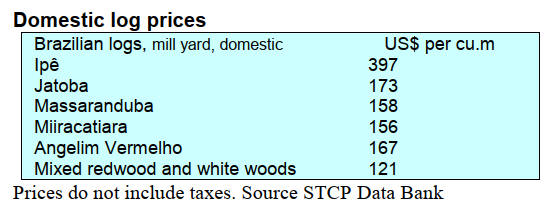
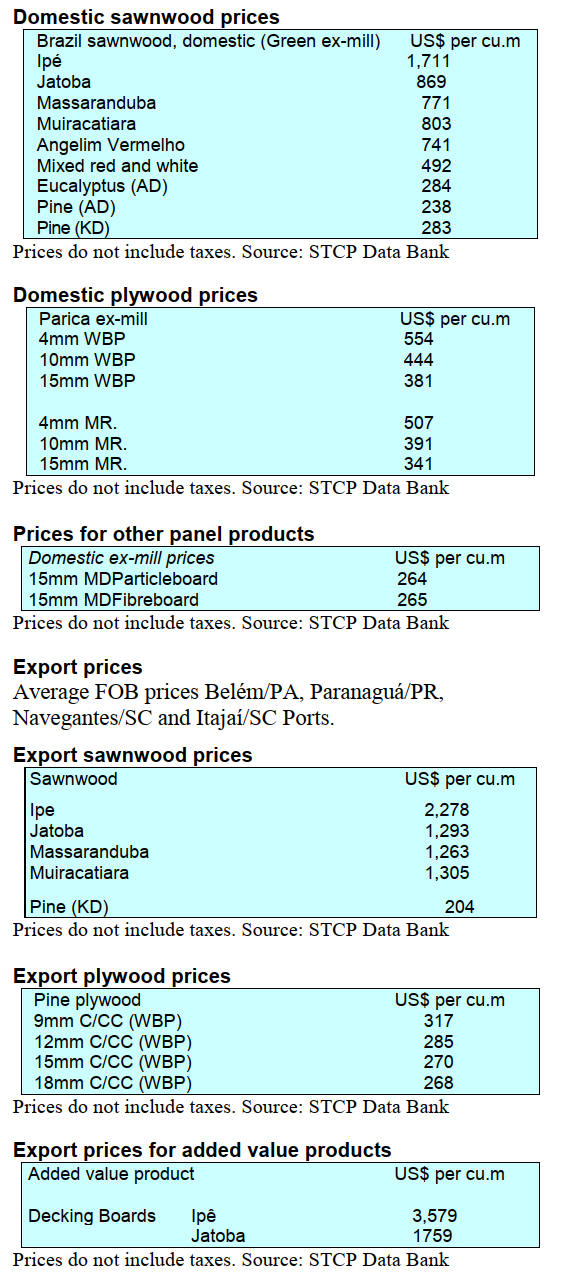
9. PERU
Furniture exports fell
in the first quarter 2025
According to the Services and Extractive Industries
Department of the Association of Exporters (ADEX),
shipments of furniture and furniture parts during the
period January-March 2025 reached an FOB export value
of US$1.1 million, a decrease of 15% year on year.
The main market for furniture and furniture parts exports
was the United States which accounted for a 48% share of
total exports of these products but this was down by a third
compared to the same period in 2024.
Other markets were Antigua and Barbuda with a 28%
share. In third place was Italy with a 16% share. Chile and
Ecuador complete the top five destinations.
Strategic alliance to improve identification of timber
species in the Amazon
With the goal of improving the identification of timber
species in the Peruvian Amazon, the Forest and Wildlife
Resources Oversight Agency (OSINFOR), the Pucallpa
Forestry CITE and the National Institute for Agrarian
Innovation (INIA) held an inter-institutional meeting in
Ucayali. This collaboration sought to strengthen technical
and scientific knowledge about the timber species found in
the forest.
In this context the coordinator of the OSINFOR Pucallpa
Decentralised Office noted that it is essential to continue
strengthening the State's coordinated work to generate
information on new forest species which will allow for
updating and expanding both existing identification
manuals and applications.
Kevin Vásquez, Director of the Pucallpa Forestry CITE
said that the supervision of forest management plans
carried out by OSINFOR represents a valuable opportunity
to gather field information by collecting botanical and
anatomical samples of species that still have knowledge
gaps.
"We have a wood technology laboratory, currently
undergoing accreditation under the ISO/IEC 17025
standard and a xylothecaries with nearly 95 registered
species. In addition, we have incorporated technological
tools such as the ARBOTROM application for precise
species identification. We believe that joining forces with
OSINFOR will optimise the collection and analysis
processes and, above all, enhance technical training in the
region," he added.
From the perspective of botanical characterisation the
National Institute of Agrarian Innovation (INIA) is a
strategic ally to contribute scientific research especially in
the areas of botanical validation and characterisation of
forest species which involves identifying, describing and
classifying species based on their morphological
characteristics.
Its participation will complement the technical work of
OSINFOR and the Pucallpa Forestry CITE, providing
scientific support for the collection, analysis and
classification processes thereby consolidating the technical
basis for sustainable forest management. As part of the
established agreements, OSINFOR, the Pucallpa Forestry
CITE and INIA defined an initial roadmap that includes
the development of a joint work plan, as well as training
on the use of technological tools and methodologies for
professionals in the sector.
This inter-institutional coordination represents a
significant step toward more sustainable and innovative
forest management, which leverages knowledge,
technology and collaborative work to protect the forests of
the Peruvian Amazon.
See: https://www.gob.pe/institucion/osinfor/noticias/1182395-
alianza-estrategica-busca-mejorar-la-identificacion-de-especies-
maderables-en-la-amazonia-peruana
Digital inter-operability in the sector
With the aim of promoting the integration of public sector
technology platforms into an inter-operable system that
facilitates information access, strengthens the traceability
of forest resources, allows for the identification of the
causes of forest degradation and enables timely decision-
making the Forest and Wildlife Resources Oversight
Agency (OSINFOR) organised a "Workshop for the
Sharing and Exchange of Experiences: Technology and
Innovation at the Service of Peru's Forests."
The event, held with the support of the Basel Institute on
Governance and the Swiss Economic Cooperation
Organisation (SECO) aimed to provide a meeting place for
public institutions and private organisations to share
experiences on the application of innovative technologies.
It also sought to generate synergies that contribute to the
development of a digital ecosystem coordinated between
the three levels of government.
To achieve an inter-operable forestry system the
Secretariat of Government and Digital Transformation
(SGTD) of the Presidency of the Council of Ministers
(PCM) proposed developing a roadmap that allows all
institutional platforms to use a standardised language.
“My data must speak for itself within the sector and must
have common standards compatible with all entities,” said
Henry Eduardo Carrión Cristóbal, an expert in National
Portfolio Management of Cross-Cutting Projects at the
SGTD.
“Only through technological innovation and inter-
institutional collaboration can we protect our forests and
guarantee a sustainable future for future generations,”
concluded Williams Arellano Olano, Head of OSINFOR.
See: https://www.gob.pe/institucion/osinfor/noticias/1178332-
avances-tecnologicos-al-servicio-de-los-bosques-peruanos-el-
osinfor-promueve-interoperibilidad-digital-en-el-sector
SERFOR positions Peru in the carbon market and
forest sustainability
As part of the Peru Carbon Forum 2025, the National
Forestry and Wildlife Service (Serfor) reaffirmed its
commitment to promoting forest carbon projects as a key
tool for addressing climate change, conserving forests and
generating sustainable economic opportunities for the
country's communities.
Currently, Peru has 22 forest carbon projects registered
under the international standard, the VERRA Verified
Carbon Standard (VCS) program, covering more than 5.5
million hectares and representing an average reduction of
15.38 million tons of CO2 equivalent per year. These
projects not only contribute to mitigating greenhouse gases
but also protect biodiversity and improve the quality of life
for local communities.
See: https://www.gob.pe/institucion/serfor/noticias/1179768-
serfor-posiciona-al-peru-como-referente-en-mercado-de-
carbono-y-sostenibilidad-forestal
Loreto government and SERFOR advance forest
zoning
To ensure sustainable management of forest and wildlife
resources, the Loreto Regional Government is promoting
the forest zoning process with technical assistance from
the Ministry of Agrarian Development and Irrigation
(MIDAGRI) through the National Forest and Wildlife
Service (SERFOR) and its Sustainable Productive Forests
Program (BPS).
Loreto represents approximately 29% of the national
territory with an area of approximately 36.9 million
hectares. Due to this the forest zoning process has been
divided into three modules.
Module 1, currently being updated, covers more than 15.9
million hectares representing 42.57% of the total area to
be zoned. This module includes the category of Ecological
Protection and Conservation Zones.
At this stage, with the technical support of the BPS
Program, official information on the department's
indigenous reserves was incorporated to classify them
within the category of Special Treatment Zones,
specifically as a subcategory of Land Reserves for
Indigenous Peoples in Isolation or Initial Contact, in order
to guarantee their protection and conservation.
In parallel, progress is being made in the formulation of
Modules 2 and 3, which will include agroforestry and
silvopastoral production areas, remnant forests, restoration
and conservation zones, non-forest plant associations and
different types of production forests (categories I, II, III),
including forest plantations.
Daniel Rivera, Executive Coordinator of SERFOR's
Sustainable Productive Forests Programme said "we have
provided professionals specialised in forest zoning and
geographic information systems, as well as equipment
with workstations, ArcGIS licenses, and an interactive
display to optimise this process in Loreto" .
See: https://www.gob.pe/institucion/serfor/noticias/1177614-
gore-loreto-y-serfor-avanzan-en-zonificacion-forestal-para-
proteger-bosques
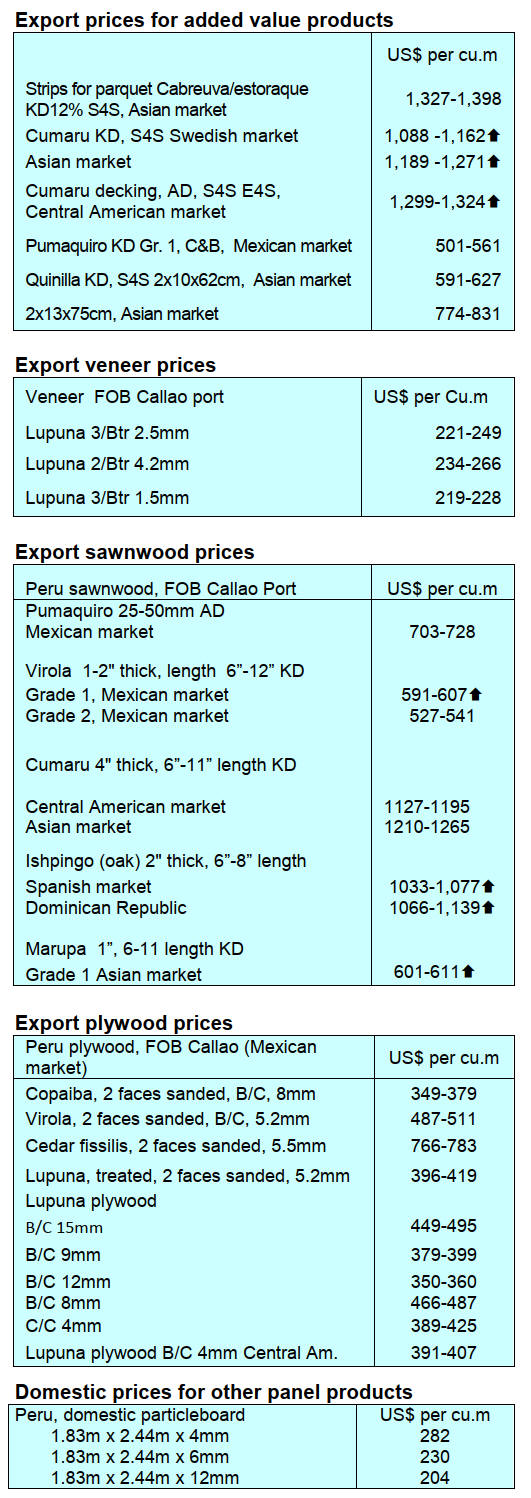
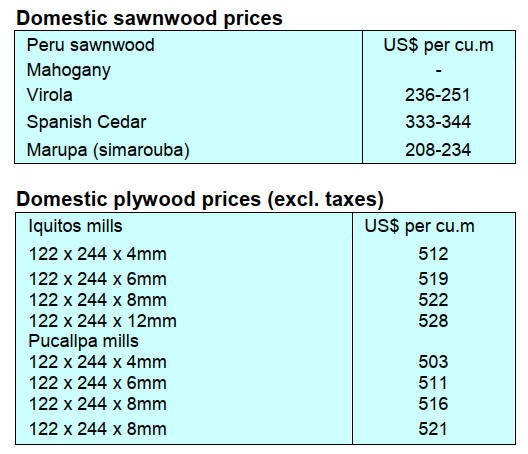
|